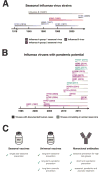Universal influenza virus vaccines and therapeutic antibodies
- PMID: 28216325
- PMCID: PMC5389886
- DOI: 10.1016/j.cmi.2017.02.009
Universal influenza virus vaccines and therapeutic antibodies
Abstract
Background: Current influenza virus vaccines are effective when well matched to the circulating strains. Unfortunately, antigenic drift and the high diversity of potential emerging zoonotic and pandemic viruses make it difficult to select the right strains for vaccine production. This problem causes vaccine mismatches, which lead to sharp drops in vaccine effectiveness and long response times to manufacture matched vaccines in case of novel pandemic viruses.
Aims: To provide an overview of universal influenza virus vaccines and therapeutic antibodies in preclinical and clinical development.
Sources: PubMed and clinicaltrials.gov were used as sources for this review.
Content: Universal influenza virus vaccines that target conserved regions of the influenza virus including the haemagglutinin stalk domain, the ectodomain of the M2 ion channel or the internal matrix and nucleoproteins are in late preclinical and clinical development. These vaccines could confer broad protection against all influenza A and B viruses including drift variants and thereby abolish the need for annual re-formulation and re-administration of influenza virus vaccines. In addition, these novel vaccines would enhance preparedness against emerging influenza virus pandemics. Finally, novel therapeutic antibodies against the same conserved targets are in clinical development and could become valuable tools in the fight against influenza virus infection.
Implications: Both universal influenza virus vaccines and therapeutic antibodies are potential future options for the control of human influenza infections.
Keywords: Influenza vaccine; Monoclonal antibody therapeutics; Pandemic influenza; Seasonal influenza; Universal influenza virus vaccine; Zoonotic influenza.
Copyright © 2017 European Society of Clinical Microbiology and Infectious Diseases. Published by Elsevier Ltd. All rights reserved.
Conflict of interest statement
Dr. Krammer receives funding from National Institutes of Health, grants from PATH, the Bill and Melinda Gates Foundation and GlaxoSmithKline. In addition, the Icahn School of Medicine has filed several patents regarding influenza virus vaccines that list Drs. Krammer and Nachbagauer as co-authors.
Figures



References
-
- WHO Fact sheet °211. http://www.who.int/mediacentre/factsheets/fs211/en/index.html.
-
- C.f.D.C.a.P. (CDC) MMWR Morb Mortal Wkly Rep. 2010;59(33):1057–62. - PubMed
-
- Palese P. Nat Med. 2004;10(12 Suppl):S82–7. - PubMed
Publication types
MeSH terms
Substances
Grants and funding
LinkOut - more resources
Full Text Sources
Other Literature Sources
Medical

